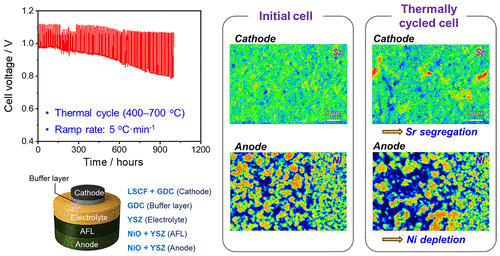当前位置:
X-MOL 学术
›
ACS Appl. Mater. Interfaces
›
论文详情
Our official English website, www.x-mol.net, welcomes your feedback! (Note: you will need to create a separate account there.)
Degradation Mechanisms of Solid Oxide Fuel Cells under Various Thermal Cycling Conditions
ACS Applied Materials & Interfaces ( IF 9.5 ) Pub Date : 2021-10-13 , DOI: 10.1021/acsami.1c13779 Ji-Seop Shin 1 , Muhammad Saqib 1 , Minkyeong Jo 1 , Kwangho Park 1 , Kwang Min Park 1 , Jin Soo Ahn 2 , Hyung-Tae Lim 3 , Jun-Young Park 1
ACS Applied Materials & Interfaces ( IF 9.5 ) Pub Date : 2021-10-13 , DOI: 10.1021/acsami.1c13779 Ji-Seop Shin 1 , Muhammad Saqib 1 , Minkyeong Jo 1 , Kwangho Park 1 , Kwang Min Park 1 , Jin Soo Ahn 2 , Hyung-Tae Lim 3 , Jun-Young Park 1
Affiliation

|
A critical issue to tackle before successful commercialization of solid oxide fuel cells (SOFCs) can be achieved is the long-term thermal stability required for SOFCs to operate reliably without significant performance degradation despite enduring thermal cycling. In this work, the impact of thermal cycling on the durability of NiO-yttria-stabilized zirconia-based anode-supported cells is studied using three different heating/cooling rates (1, 2, and 5 °C min–1) as the temperature fluctuated between 400 and 700 °C. Our experiments simulate time periods when power from SOFCs is not required (e.g., as might occur at night or during an emergency shutdown). The decay ratios of the cell voltages are 8.8% (82 μV h–1) and 19.1% (187 μV h–1) after thermal cycling testing at heating/cooling rates of 1 and 5 °C min–1, respectively, over a period of 1000 h. The results indicate SOFCs that undergo rapid thermal cycling experience much greater performance degradation than cells that experience slow heating/cooling rates. The changes in total resistance for thermally cycled cells are determined by measuring the Rpol of the electrodes (whereas the ohmic resistances of the cells remain unchanged from their initial value), signifying that electrode deterioration is the main degradation mechanism for SOFCs under thermal cycling. In particular, fast thermal cycling leads to severe degradation in the anode part of SOFCs with substantial agglomeration and depletion of Ni particles seen in our characterizations with field emission–scanning electron microscopy and electron probe microanalysis. In addition, the mean particle size in the cathode after thermal cycling testing increases from 0.104 to 0.201 μm for the 5 °C min–1 cell. Further, the presence of Sr-enriched regions is more significant in the La0.6Sr0.4Co0.2Fe0.8O3−δ cathode after fast thermally cycled SOFCs.
中文翻译:

不同热循环条件下固体氧化物燃料电池的降解机理
在固体氧化物燃料电池 (SOFC) 成功商业化之前要解决的一个关键问题是 SOFC 需要长期热稳定性才能可靠运行而不会显着降低性能,尽管经受住了热循环。在这项工作中,使用三种不同的加热/冷却速率(1、2 和 5 °C min –1)作为温度研究了热循环对 NiO-氧化钇稳定的氧化锆基阳极支撑电池的耐久性的影响在 400 到 700 °C 之间波动。我们的实验模拟了不需要来自 SOFC 的电力的时间段(例如,可能发生在夜间或紧急关闭期间)。电池电压的衰减率为 8.8% (82 μV h –1 ) 和 19.1% (187 μV h –1) 在加热/冷却速率分别为 1 °C min –1和 1000 小时的热循环测试后。结果表明,经历快速热循环的 SOFC 比经历缓慢加热/冷却速率的电池经历了更大的性能下降。热循环电池总电阻的变化是通过测量R pol来确定的电极的电阻(而电池的欧姆电阻与其初始值保持不变),这表明电极劣化是热循环下 SOFC 的主要降解机制。特别是,快速热循环导致 SOFC 阳极部分的严重降解,在我们的场发射扫描电子显微镜和电子探针微量分析表征中可以看到 Ni 颗粒的大量聚集和消耗。此外,对于 5 °C min –1电池,热循环测试后阴极中的平均粒径从 0.104 μm 增加到 0.201 μm 。此外,在 La 0.6 Sr 0.4 Co 0.2 Fe 0.8 O 中,Sr 富集区的存在更为显着快速热循环 SOFC 后的3-δ阴极。
更新日期:2021-10-27
中文翻译:

不同热循环条件下固体氧化物燃料电池的降解机理
在固体氧化物燃料电池 (SOFC) 成功商业化之前要解决的一个关键问题是 SOFC 需要长期热稳定性才能可靠运行而不会显着降低性能,尽管经受住了热循环。在这项工作中,使用三种不同的加热/冷却速率(1、2 和 5 °C min –1)作为温度研究了热循环对 NiO-氧化钇稳定的氧化锆基阳极支撑电池的耐久性的影响在 400 到 700 °C 之间波动。我们的实验模拟了不需要来自 SOFC 的电力的时间段(例如,可能发生在夜间或紧急关闭期间)。电池电压的衰减率为 8.8% (82 μV h –1 ) 和 19.1% (187 μV h –1) 在加热/冷却速率分别为 1 °C min –1和 1000 小时的热循环测试后。结果表明,经历快速热循环的 SOFC 比经历缓慢加热/冷却速率的电池经历了更大的性能下降。热循环电池总电阻的变化是通过测量R pol来确定的电极的电阻(而电池的欧姆电阻与其初始值保持不变),这表明电极劣化是热循环下 SOFC 的主要降解机制。特别是,快速热循环导致 SOFC 阳极部分的严重降解,在我们的场发射扫描电子显微镜和电子探针微量分析表征中可以看到 Ni 颗粒的大量聚集和消耗。此外,对于 5 °C min –1电池,热循环测试后阴极中的平均粒径从 0.104 μm 增加到 0.201 μm 。此外,在 La 0.6 Sr 0.4 Co 0.2 Fe 0.8 O 中,Sr 富集区的存在更为显着快速热循环 SOFC 后的3-δ阴极。


























 京公网安备 11010802027423号
京公网安备 11010802027423号